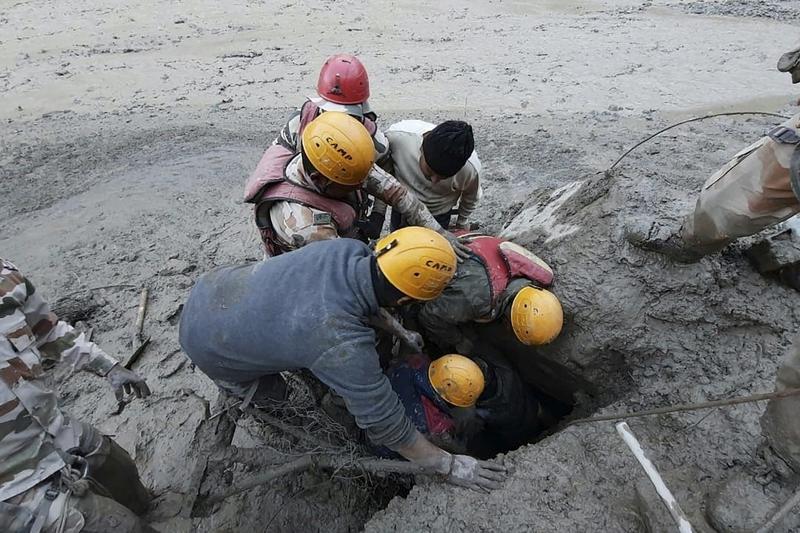 This handout photo taken on February 7, 2021 and released by the Indo-Tibetan Border Police (ITBP) shows members of the ITBP during a rescue operation after a broken glacier caused a major river to surge and overflow, sweeping away bridges and roads, at Reni village in Chamoli district of Uttarakhand. (INDO-TIBETAN BORDER POLICE / AFP)
This handout photo taken on February 7, 2021 and released by the Indo-Tibetan Border Police (ITBP) shows members of the ITBP during a rescue operation after a broken glacier caused a major river to surge and overflow, sweeping away bridges and roads, at Reni village in Chamoli district of Uttarakhand. (INDO-TIBETAN BORDER POLICE / AFP)
LUCKNOW, India - Rescuers searched for more than 200 people missing in the Indian Himalayas on Monday, including some trapped in a tunnel, after part of a glacier broke away, sending a torrent of water, rock and dust down a mountain valley.
Sunday’s violent surge below Nanda Devi, India’s second-highest peak, swept away a small hydro electric project called Rishiganga and damaged a bigger one further downstream the Dhauliganga river being built by state-firm NTPC.
Eighteen bodies have been recovered from the mountainsides, officials said.
ALSO READ: 10 bodies recovered after glacier burst in north India
Sunday’s violent surge below Nanda Devi, India’s second-highest peak, swept away a small hydro electric project and damaged a bigger one further downstream the Dhauliganga river
Most of the missing were people working on the two projects, part of the many the government has been building deep in the mountains of Uttarakhand state as part of a development push.
“As of now, around 203 people are missing,” state chief minister Trivendra Singh Rawat said, and the number was changing as more information about people caught up the deluge emerged from the remote area.
Videos on social media showed water surging through a small dam site, washing away construction equipment and bringing down small bridges.
“Everything was swept away, people, cattle and trees,” Sangram Singh Rawat, a former village council member of Raini, the site closest to the Rishiganga project, told local media.
It was not immediately clear what caused the glacier burst on a bright Sunday morning. Experts said it had snowed heavily last week in the Nanda Devi area and it was possible that some of the snow started melting and may have led to an avalanche.
READ MORE: Over 5.6m people affected by floods in India's Assam, 93 dead
 This photograph provided by National Disaster Response Force shows NDRF personnel preparing to rescue workers at one of the hydropower project at Reni village in Chamoli district of Indian state of Uttrakhund, Feb 8, 2021. (PHOTO NATIONAL DISASTER RESPONSE FORCE VIA AP)
This photograph provided by National Disaster Response Force shows NDRF personnel preparing to rescue workers at one of the hydropower project at Reni village in Chamoli district of Indian state of Uttrakhund, Feb 8, 2021. (PHOTO NATIONAL DISASTER RESPONSE FORCE VIA AP)
Rescue squads were focused on drilling their way through a 2.5 kilometer-long tunnel at the Tapovan Vishnugad hydropower project site that NTPC was building five km downstream where about 30 workers were believed trapped.
“We are trying to break open the tunnel, it’s a long one, about 2.5 km,” said Ashok Kumar, the state police chief. He said rescuers had gone 150 meters into the tunnel, but debris and slush was slowing progress.
There had been no voice contact yet with anyone in the tunnel, another official said.
On Sunday, 12 people were rescued from one tunnel
On Sunday, 12 people were rescued from another tunnel that was much smaller.
Trigger for glacier burst
Uttarakhand is prone to flash floods and landslides and the disaster prompted calls by environment groups for a review of power projects in the ecologically sensitive mountains. In June 2013, record monsoon rains there caused devastating floods that claimed close to 6,000 lives.
A team of scientists were flown over the site of the latest accident on Monday for surveillance to find out what exactly happened.
“It’s a very rare incident for a glacial burst to happen. Satellite and Google Earth images do not show a glacial lake near the region, but there’s a possibility that there may be a water pocket in the region,” said Mohd Farooq Azam, assistant professor, glaciology & hydrology at the Indian Institute of Technology in Indore.
Water pockets are lakes inside the glaciers, which may have erupted leading to this event. Environment groups have blamed construction activity in the mountains.
Himanshu Thakkar, co-ordinator of the South Asia Network of Dams, Rivers and People, said that there were clear government recommendations against the use of explosives for construction purposes. “There have been violations.”
The latest accident had also raised questions about the safety of the dams. “The dams are supposed to withstand much greater force. This was not a monsoon flood, it was much smaller.”
READ MORE: Did Kerala's dams exacerbate India's once-in-century floods?


